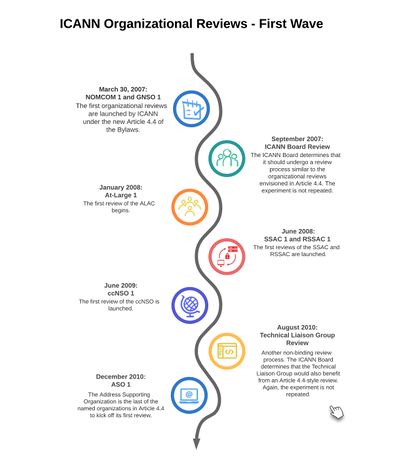ICANN Historical Timeline
ICANN's history and the history of the Internet are interlinked, and the mission of ICANN was carried out prior to its formation by volunteers, governmental actors, and academic institutions. The following is an attempt to categorize the history (and prehistory) of ICANN and the Domain Name System into eras. Some eras are defined by technical and technological advances, while others are defined by policy initiatives, structural or operational changes to ICANN org, or a broader thematic push. For instance, the present era involves the globalization of access to and use of the Internet; despite ICANN being committed to the global Internet community from its inception, several trends are converging to make the present moment a fight for global and universal access and acceptance: the BRIC countries will represent the vast majority of Internet growth in the coming decade; Internationalized Domain Names are growing in prominence and the effort to ensure universal acceptance of alternate language scripts is as well; efforts to nationalize the DNS by China and Russia are forcing a broader conversation about the value and impact of a global Internet; and ICANN itself is aggressively seeking to improve its presence in and outreach to under-represented parts of the world.
This should not be taken as a canonical resource regarding ICANN's evolution. Technological and policy initiatives overlap. The boundaries for each era are necessarily fuzzy. Although the effort is to identify themes within the events and history of a given era, there is no guarantee that we have it "right," or that there is a "perfectly correct" representation of a given timeframe.
1968-1976: DARPA Era - The Birth of the Internet edit
ARPANET edit
-
NLS System at Stanford, 1968[1]
-
The "Mother of All Demos," 1968[2]
-
Concept drawing of ARPANET, 1969[3]
-
Interface Message Processor, 1969[4]
-
Queen Elizabeth II sends an email, 1976[5]
The ARPANET was a product of DARPA, the Defense Advanced Research Projects Agency. MIT, the University of Southern California, UCLA, and the Stanford Research Institute, under contract with DARPA, were all instrumental in the development of technologies that are still used today in the modern Internet.[6] Jon Postel, Vint Cerf, Steve Crocker, and other Internet pioneers were first connected with ARPANET projects and innovations.
1976 - edit
1983 - 1989: Birth of the DNS edit
1986 - NSF launches NSFNet 1987 - Over 20,000 servers online hosting websites
1988 - IANA (legitimization era) edit
1992 - Internet goes commercial/ gains a public/ officially becomes marketplace edit
1994 - RFC 1591 edit
1996 Internet Governance blueprint era: International Ad-Hoc Committee formed edit
1997 - MoU 1998 - green/white papers
1998 Birth of ICANN (scaffolding) edit
1999-2002: (infant) ICANN edit
Privatization Marilyn Cade DNSO exists PSO, ASO are reserved
2002 ICANN Reform (toddler) edit
2003 2004
2005-2006 (youth) fulfillment of Differentiation/Expansion of ICANN bodies edit
2007 - 2009 (youth) Infinite reviewing cycles begin edit

The ICANN Bylaws call for two different types of review - organizational reviews (Article 4.4) and specific reviews (Article 4.6). Article 4.4 reviews were born from the 2002 Evolution and Reform Process, and require periodic review of ICANN's supporting organizations and advisory committees. Article 4.6 reviews originated in the Affirmation of Commitments, and the first round of "specific" reviews occurred before these reviews were enshrined in the bylaws. The amendment to the bylaws came about as a result of the IANA Functions Stewardship Transition, when it was recommended that the bylaws be revised to incorporate ICANN's obligations under the Affirmation of Commitments.
As the organizational reviews began, ICANN was in the process of entering into the Affirmation of Commitments with the United States Department of Commerce. As a result, the first specific reviews were launched in 2010, while most of the organizational reviews were still in progress or only recently completed. Many community members since that date have commented on what seems to be a relentless cycle of reviews of one aspect of ICANN, or another, or both at once.
ATRT 3 addressed this issue head-on, suggesting that organizational reviews be replaced by "continuous improvement programs," the results of which could feed into a single, "holistic" review of the organization and its constituent parts, to be performed on a periodic basis. In addition, the ATRT 3 team recommended suspending the next cycle of specific reviews until the completion of the next Accountability and Transparency Review. These recommendations were met with varying levels of enthusiasm. The ICANN Board approved the recommendations in the fall of 2020, with caveats. On the specific review side, the board noted that community approval would be required to amend the bylaws around specific reviews. In the organizational review reforms, the board agreed to implement pilot projects testing both the "holistic" review model and a continuous improvement model.
![NLS System at Stanford, 1968[1]](/images/thumb/e/e1/NLS_-_Stanford_1968.jpg/120px-NLS_-_Stanford_1968.jpg)
![The "Mother of All Demos," 1968[2]](/images/thumb/e/e8/1968b_MOAD.jpg/120px-1968b_MOAD.jpg)
![Concept drawing of ARPANET, 1969[3]](/images/thumb/4/4a/1969_ARPANET_290x230.png/120px-1969_ARPANET_290x230.png)
![Interface Message Processor, 1969[4]](/images/thumb/a/af/1969a_ARPANET_full.jpg/58px-1969a_ARPANET_full.jpg)
![Queen Elizabeth II sends an email, 1976[5]](/images/thumb/8/84/Queen-Elizabeth-II-sending-her-first-e-mail.jpg/120px-Queen-Elizabeth-II-sending-her-first-e-mail.jpg)